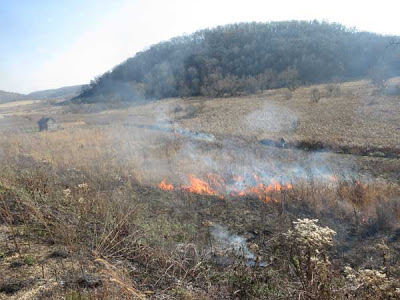Why burn a prairie this time of year?
Yesterday we burned the 3-acre Crane Prairie. This long, narrow prairie is sandwiched between our wetland and the large south-slope prairie remnant. We needed a wind from the south to keep the fire out of the wetland and a large enough crew so that we could keep the south slope prairie from burning. Fortunately, one of our contractors, Michler/Brown, was nearby doing another burn and came over to help us.
The burn took about an hour to complete and we had no trouble with spot fires.
We burned this prairie in the fall because we wanted to spray resprouts of undesirable species in the early spring. Burning in the fall is good because all vegetation has died back so that it is unaffected by the burn. If one burns in the spring, early species have generally already started to grow and are set back by the burn.
The main problem with a fall prairie burn is that a lot of the vegetation is still green and does not burn well. Also, since this is a wet mesic prairie, ground water is close to the surface. However, the Crane Prairie (which had just finished its 7th growing season) has lots of Indian grass, which is the best fuel for a prairie burn.
By burning in the fall we can monitor the prairie in early spring and start foliar spraying as soon as bad plants are visible.What species are we spraying? Anything undesirable. Brambles and pale Indian plantain (a clonal species that is especially difficult to control). Also, reed canary grass, burdock, Canada thistle, and Canada goldenrod, all of which appear early.
 |
| We monitored the large prairie on the south-facing slope for spot fires using Pleasant Valley Road as a base. |
We burned this prairie in the fall because we wanted to spray resprouts of undesirable species in the early spring. Burning in the fall is good because all vegetation has died back so that it is unaffected by the burn. If one burns in the spring, early species have generally already started to grow and are set back by the burn.
The main problem with a fall prairie burn is that a lot of the vegetation is still green and does not burn well. Also, since this is a wet mesic prairie, ground water is close to the surface. However, the Crane Prairie (which had just finished its 7th growing season) has lots of Indian grass, which is the best fuel for a prairie burn.
By burning in the fall we can monitor the prairie in early spring and start foliar spraying as soon as bad plants are visible.What species are we spraying? Anything undesirable. Brambles and pale Indian plantain (a clonal species that is especially difficult to control). Also, reed canary grass, burdock, Canada thistle, and Canada goldenrod, all of which appear early.



0 Comments:
Post a Comment
Subscribe to Post Comments [Atom]
<< Home